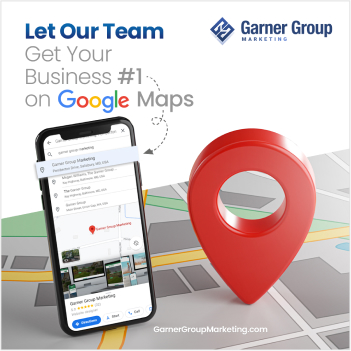The Customer Acquisition Cost Formula in 5 easy steps
Courtesy of Digital Marketer, modified for Garner Group Marketing
This five-step process will work for ANY business. It works for digital companies like Garner Group Marketing, phone-based selling companies, and even brick-and-mortar stores.
Don’t get intimidated by the calculations here and get hung up on the details trying to get the exact number down to the penny.
If you’re just getting started, it’s OK if your numbers aren’t exactly right!
Do what you can. Start with a ballpark figure go from there. Over time you can refine that number to get more exact and specific to your business.
Here is the five-step Customer Acquisition Cost Formula I promised:
Customer Acquisition Cost Formula Step 1: Estimate How Much a Customer Is Worth
The first thing you’ll need to figure out is:
How much revenue do you generate from a customer over the life of their relationship with you?
Keep in mind this extends beyond the revenue you generate from your initial sale. Your initial sale might only bring you $50, but many of the customers who buy that $50 product will go on to make additional purchases.
So, if your products cost $50 each, and each customer buys five products on average, then a customer is worth $250 on average. If each customer buys six products on average, then a customer is worth $300 on average.
Make sense?
This is known as your customer lifetime value, and it’s an extremely valuable metric to know about your business.
There are three ways you can figure out this metric:
Customer Lifetime Value Method #1: Ask Your Data Analyst to Figure It Out
If you have a Data Analyst or other analytic whiz on your team, just ask them to figure it out for you. Easy peasy.
Customer Lifetime Value Method #2: Calculate It On Your Own
To calculate this on your own, there are two things you need to know:
- How many customers bought your products.
- How much total revenue you generated.
You’ll need to choose a date range for this data. I recommend going back 12 full months, if you can, to get lots of data. If you don’t have that much data then try to go back 90 days.
Then, you simply divide the total revenue by the total number of customers: Revenue / Customers = Customer Lifetime Value.
Revenue / Customers = Customer Lifetime Value.
For example: Say you generated $156,250 in revenue over the past 12 months, and over that time 1,250 customers bought your products.
Just divide $156,250 / 1,250 = $125.
This number, $125, is your customer lifetime value.
Customer Lifetime Value Method #3: Estimate It to Get a Starting Point
Now if you don’t have the data available to follow Method #2, that’s OK. You can start out by estimating your CLTV.
A good benchmark to start with is anywhere from two to eight times the price of your initial conversion value.
So, to stick with our example here, if our company’s first conversion value is $25, then a good benchmark to start with would be anywhere from $50-$200.
For this example, we’re going to go in the middle, with $25 x 5 = $125 customer lifetime value.
Customer Acquisition Cost Formula Step 2: Subtract Refunds & Cancellations
The next step is to figure out how many people ask for their money back and subtract that from your CLTV.
This is something you can figure out from your CRM. But if you don’t have access to that data, you can use 10% as a conservative benchmark.
So now that you have your refund rate, subtract that from the CLTV that you calculated in Step 1.
Let’s say that your refund rate is 10%. Our Step 1 CLTV was $125, and 10% of that is $12.50.
Customer Acquisition Cost Formula Step 3: Subtract Cost of Goods Sold
Next, you need to subtract how much it costs to actually manufacture and deliver your goods.
This figure can vary wildly. For an agency like Garner Group Marketing, all I’m paying for is the servers to house the data and the labor. But for an actual physical product, the cost of goods could be much higher.
(And don’t forget to include the cost of shipping!)
For the fictitious product in our example, let’s pretend it’s a digital product where the cost of goods sold is 10% of the CLTV, or $12.50.
Customer Acquisition Cost Formula Step 4: Subtract Overhead Costs
Next, you need to account for overhead costs, which are different than the cost of goods sold.
Your overhead includes things like…
- Payroll
- Utilities
- Software
- Accounting
- Legal Expenses
Multiply your overhead by your CLTV. For our fictitious example, say overhead is 30% of the CLTV: $250 x 30% = $75.
Customer Acquisition Cost Formula Step 5: Subtract Desired Profitability
We started with your total revenue per customer (CLTV) and subtracted all the costs associated with producing that product, including:
- Refunds
- Cost of Goods
- Overhead
Let’s calculate everything to get an idea of where we’re at:
CLTV – Refunds – Cost of Goods – Overhead
$250 – $25 – $25 – $75 = $125
In other words, out of the $250 that you generate per customer, half of it ($125) goes toward creating and delivering your products. And you have $125 left over.
Does that mean you can afford to spend $125 to acquire a new customer?
Technically, yes, but then you wouldn’t be making any profit. You’d be breaking even on every customer.
So, the last thing you need to do is decide what sort of profit margin you want to earn.
This number will depend on a lot of different things like…
- your business model
- the industry you’re in
- what your cash flow situation is
…and more.
For a digital product, a good profit margin to shoot for is between 20% and 40%.
Here’s what that would look like for our fictitious example:
- 20% x $250 = $50 profit per customer
- 30% x $250 = $75 profit per customer
- 40% x $250 = $100 profit per customer
So, how do you choose which profit margin will work best?
This is where you want to refer back to the number we calculated above. Out of our $250 CLTV, $125 was used to produce and deliver the product. That means we have only $125 remaining.
If we chose a profit margin of 40%, we would earn $100 in profit for every customer. However, that would leave us only $25 to acquire new customers ($125 – $100). That’s NOT a lot of money to acquire new customers.
If we chose a more conservative profit margin of 20%, on the other hand, we would earn only $50 in profit for every customer. But that would also leave us with a healthy $75 in customer acquisition costs ($125 – $50).
So, let’s say that we decide that our desire profitability will be 20%. In this case, we can spend up to $75 to acquire a new customer. That’s our tolerable customer acquisition cost.
This is how much money is left over from the customer’s lifetime value after accounting for refunds, cost of goods, overhead, and profitability.
“The Money Left Over from the customer’s lifetime value minus overhead is the amount you can spend to acquire a new customer”
A Couple Important Things to Keep in Mind
Now that you have a basic idea of how to calculate your customer acquisition cost, there are a couple things that you’ll want to keep in mind as you’re thinking about this stuff.
1. How to Use Your Customer Acquisition Cost to Figure Out Other Metrics
I often hear questions like this:
“What’s a good cost per click?” Or, “What’s a good cost per lead?”
That’s a hard question to answer without knowing your customer acquisition cost. But once you know your CAC, suddenly it becomes a lot easier to figure out what these other metrics should be.
For example, if you can spend up to $75 to acquire a new customer, and you know that your sales team converts 10% of leads into customers, then that means you can afford to spend up to $7.50 to acquire a lead ($75 x 10%).
And if your landing page converts 40% of visitors into leads, that means you can afford to spend up to $3 per click ($7.50 x 40%).
Make sense?
These numbers are highly dependent on your business. Let’s say that the company in our example creates a new product that increases their customer lifetime value (CLTV).
After releasing this product, they’re able to spend $100 to acquire a new customer. Now they can afford to spend $10 per lead.
Do you see how these different traffic and business metrics are all related to one another?
And it all starts with figuring out how much you can afford to pay to acquire a new customer. Once you know that number, then you can work backward and figure out what your CPL (cost per lead) should be.
2. Your Cash Flow Situation Could Change Things
Finally, and this is really important…
Remember that it takes time for any ad campaign to start generating revenue. The vast majority of companies do NOT see an ROI on the same day they start an ad campaign.
So, that begs the question: Just how long can you afford to wait before seeing an ROI on your campaigns?
The answer to that question will help guide your customer acquisition strategy. If the backend of your business generates a profit on new customers after 60 days, but you need to generate that revenue within 30 days because of your cash flow situation, then you’re not going to be able to spend as much money to acquire a new customer.
“When I started Garner Group Marketing, we didn’t have a lot of cash on hand. Cash flow was tight, which meant that whenever we spent money to acquire a new customer, we had to break even on that customer pretty much the same month.”
Today, however, our financial situation has changed. Now we can comfortably wait 30-60 days before generating profit on our customers.
This allows me to scale more than we could in the past. It also allows me to pay more than our competitors to acquire new customers.
“He or she who can spend the most to acquire a new customer, wins.”
Now Go Calculate Your Customer Acquisition Cost
By now you should know exactly how to figure out how much you can afford to acquire a new customer.
Remember, it doesn’t have to be exact. You can start with a ballpark figure now, and make it more accurate over time. Just having a general idea of your CAC is enough to help you make better decisions in all your traffic campaigns in the future.
So, get out there and figure out your customer acquisition cost!
[/fusion_text][/fusion_builder_column][/fusion_builder_row][/fusion_builder_container]






